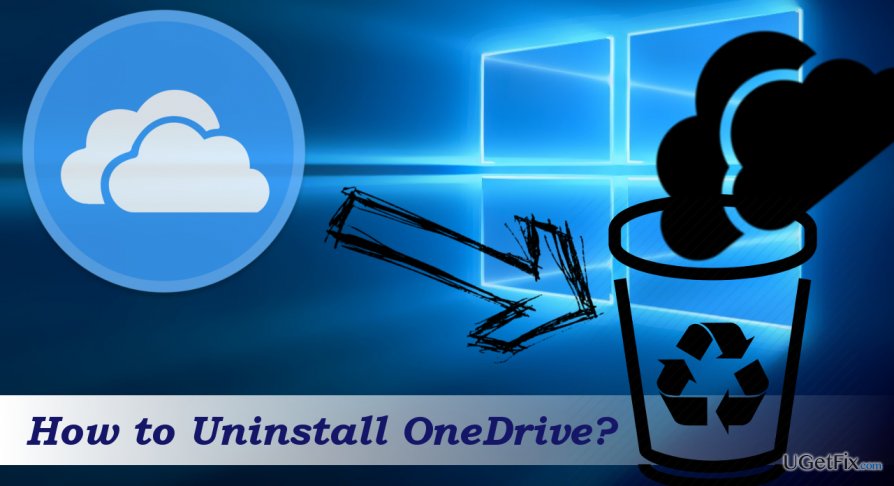Question
Issue: How to Uninstall OneDrive?
Isn’t OneDrive a default Windows 10 app? I would like to uninstall it, but I wonder if it’s one of the default apps, removal will either be forbidden or may cause some problems. Am I wrong?
Solved Answer
OneDrive is a handy Microsoft service used by millions of people worldwide. It allows a computer, laptop, tablet, and smartphone users to store and share data on the Internet. OneDrive can be referred to as a data storage, except that it does not require having an external drive (USB, DVD, CD, etc.) by hand. To use it, a PC or another device with the Internet connection is the only must. All Microsoft Windows users can use OneDrive for free. However, those who run older Windows versions, including 7, 8, 8.1 or XP have to install the app from the Windows Store manually; whereas with the Windows 10, OneDrive comes by default, meaning that its removal was not permitted. Luckily, Creators Update brought many changes, one of which is the permission to Uninstall OneDrive. Windows 10 Home users are now able to uninstall it just like any other application. However, Windows 10 Professional, Education, and Enterprise users will have to use Registry Editor or the Local Group Policy Editor for its removal. Luckily, neither of the methods is difficult, except that you should be careful while executing modifications on Registry Editor and Local Group Policy Editor because any inaccurate move can cause system errors.

Uninstalling OneDrive From Programs and Features in Windows 10 Home
This method is only available for Windows 10 Home Users.
- Right-click on “Windows key” and select “Control Panel.”
- Select “Programs and Features” and locate “Microsoft OneDrive” on the list.
- Click it and select “Uninstall.”
- Click “Yes” on the UAC window to confirm the removal.
IMPORTANT: after removing OneDrive via Control Panel, you will still see an empty OneDrive folder in File Explorer. If it doesn’t annoy you, then everything is OK because OneDrive is no longer functioning on your Windows system. If, however, you opt for deleting the service completely and make all its folders disappear, try the following removal methods:
Removing OneDrive from File Explorer in Windows 10 Home, Pro, Enterprise
This method requires editing some Registry keys. Therefore, we would strongly recommend you to backup Windows Registry in the case of a failure.
- Press “Windows key,” type “regedit,” and press “Enter.”
- Click “Yes” on the UAC.
- Using the left pane navigate to the HKEY_CLASSES_ROOT\CLSID\{018D5C66-4533-4307-9B53-224DE2ED1FE6} key ( 32-bit system).
- Using the left pane navigate to the HKEY_CLASSES_ROOT\Wow6432Node\CLSID\{018D5C66-4533-4307-9B53-224DE2ED1FE6\ key (64-bit system).
- Double-click on the System.IsPinnedToNameSpaceTree and set its value to 0.
- Press “OK” to save the changes.
Uninstalling OneDrive with the Local Group Policy Editor in Home, Professional, Enterprise, or Education
- Open “Start,” type “gpedit.msc,” and press “Enter.”
- Use the left pane to navigate to the “Computer Configuration” -> “Administrative Templates” -> “Windows Components” -> “OneDrive.”
- Double-click on the “Prevent the usage of OneDrive for file storage” policy setting and set it to “Enabled.”
- Click “OK” to save the changes.
TIP: In case you would change your mind and decide to start using OneDrive, you should open the Local Group Policy Editor as explained above and set “Prevent the usage of OneDrive for file storage” policy setting to “Not Configured.”
If you have uninstalled OneDrive from Programs and Features or Windows Registry, you can reinstall it at any time. For that you should navigate to the C:\Windows\SysWOW64\ folder on a 64-bit version of Windows 10 or the C:\Windows\System32 folder on a 32-bit version of Windows 10, double-click on the “OneDriveSetup.exe” file, and wait for OneDrive to reinstall.
Get rid of programs with only one click
You can uninstall this program with the help of the step-by-step guide presented to you by ugetfix.com experts. To save your time, we have also selected tools that will help you carry out this task automatically. If you are in a hurry or if you feel that you are not experienced enough to uninstall the program by your own, feel free to use these solutions:
Protect your online privacy with a VPN client
A VPN is crucial when it comes to user privacy. Online trackers such as cookies can not only be used by social media platforms and other websites but also your Internet Service Provider and the government. Even if you apply the most secure settings via your web browser, you can still be tracked via apps that are connected to the internet. Besides, privacy-focused browsers like Tor is are not an optimal choice due to diminished connection speeds. The best solution for your ultimate privacy is Private Internet Access – be anonymous and secure online.
Data recovery tools can prevent permanent file loss
Data recovery software is one of the options that could help you recover your files. Once you delete a file, it does not vanish into thin air – it remains on your system as long as no new data is written on top of it. Data Recovery Pro is recovery software that searchers for working copies of deleted files within your hard drive. By using the tool, you can prevent loss of valuable documents, school work, personal pictures, and other crucial files.



